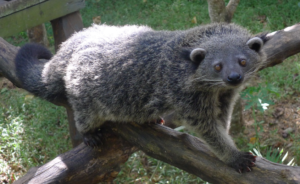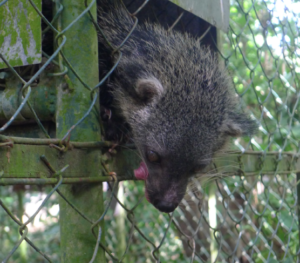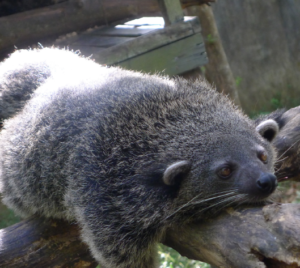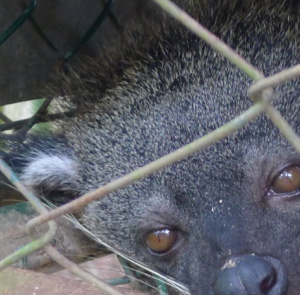During a recent trip to the Palawan Wildlife Rescue and Conservation Center (PWRCC) with my kids, one particular animal caught my attention and triggered a sense of nostalgia: the graceful Palawan bearcat, locally called ‘binturong’.
During 80s and earlier, almost every Palawan household had some sort of pet, and ours was a pair of Binturongs.
Though I’ve been familiar with the Binturong since childhood, I’ve always wondered why it is called Palawan bearcat. I’ve been to Singapore Zoo a few times, where I like to watch the evening animal show The opening act is always the same: two bearcats from opposite sides of the arena climb down from a rope stretching the whole length of the venue. My old friend, Doctor Glen Rebong, former project director of the PWRCC, explains that though the bearcat can be exists in most parts of Southeast Asia and in some parts of continental Asia, here in the Philippines, it can only be found in Palawan.

The Palawan Bearcat Vs. the Musang
Neither a bear nor a cat, its distant relative is the musang (Editor’s note: Mr. Lao’s article on the Musang came out in our November 2015 issue) and they share the same taxonomic family. While the Musang looks like a cross between a weasel and a cat, the Binturong really does look like a cross between a bear and a cat. When it comes to body length and gait, a Bearcat is the giant cousin of the Musang.It is much stockier than the musang, which only weighs about 2 to 4 kilograms (kg). The Binturong can reach a hefty weight of 20 kg; overfed and under-exercised captive specimens can weigh much more. A musang only grows to a little over 3 feet in length while a bearcat can grow to a length of almost 5 feet, with its tail accounting for about half of the length.The gait can somewhat be described by our old observation of these animals when they sleep. A musang sleeps like a cat and a sleeping bearcat looks like a piece of log.
Much like that of a cat, the tail of a musang helps the animal keep its balance. For a bearcat, the tail is so much more; long, muscular, and agile, it is essential for the bearcat to climb up and down trees—and for captive specimens, climbing up and down practically anything. Since bearcats are bulkier and heavier than musangs and cats, climbing—particularly climbing down—poses a big challenge to them. It is more difficult for them to maintain their grasp on something using their claws, and there is a big risk of falling, especially when climbing trees with loose bark.

If you see a bearcat move, whether in a tree or on the ground, its tail instinctively and continuously searches for something to grasp. Many years ago, when we still had our bearcats, at times when they were in a playful mood, they would climb up my body, grasp my extended arm with their tail, then swing back down to the ground. That is actually how I became familiar with their weight. They felt like a couple of oversized dumbbells when they played that game, and their tail was more than capable of supporting their weight. The tail is also useful as a pillow or blanket during cold days.
The coat of the bearcat is black with some shades of grey, and it is thick and coarse. It also has a musky odor like an overripe fruit. This odor is secreted by scent glands located at the animal’s posterior. The scent is probably for marking territory and identifying the gender and characteristics of each individual animal. Like a cat, it can hiss or make an angry version of “meow” when threatened or irritated. But most of the time, they do not make any audible sound and they remain stealthy.
Though they share some facial similarities with the musang, the Binturong has very different habits. Musang are usually active during the night, and like the cat, they are alert, jumpy, and fast. A Binturong on the other hand is slower, almost to the point of being sluggish. They also move in a mysteriously graceful manner, like they are in perpetual slow motion. This sometimes gives the impression that they are easy to get hold of. But I have come learn that their movement is that of grace and efficiency. When moving away, they do not appear to be running up the tree, but they will be gone in a few seconds.

It is this grace and calmness that makes me love to watch the Bearcats of PWRCC, and before I know it, I have been watching them for more than an hour. Bearcats are essentially omnivores, so they eat both fruit and meat. However, as they are not fond of sudden movements, they are more of opportunistic hunters. They eat smaller animals, worms, insects, and grubs when these blunder across a bearcat’s path. Furthermore, they stay in the trees most of the time so they have to rely heavily on fruit for their diet.
Up Close and Personal with the Bearcat
Thinking back to our beloved Binturongs, they made good companions. They were so tame that we allowed them to stay inside the house for days at a time. They would nest in the upper railings of the sliding door and mostly sleep during the day. We knew that they came down and explored the house during the night because we could hear them playing and strolling about. They only defecated and urinated in one place, so you could say they are tidy animals. However, due to their size and appetite, their excretions accumulate fast and we had to transfer them back to their cage in order to clean up.
They can down a whole bunch of Saba bananas in a couple of days. Other parts of their regular diet are papaya and supplemental milk. But the banana made up more than 50% of their daily diet. They also got treats of other fruits that were in plentiful supply due to fruiting season or the holidays: mangoes, apples, pears, aratiles or seresas, langka, caimito, guyabano, and so on.
Before we went to sleep at night, we made sure that there was ample food and water near the bearcats’ den; otherwise, we would find the house in disarray the next morning, courtesy of two hungry bearcats searching for a meal. I would describe their behavior while they were living with us to be somewhat like that of cats. Unlike dogs, who are very eager to please, the Bearcats are aloof and want to have their own space and time. When we approached them, they do not show any obvious sign of fear or fondness. They just looked at us with a satisfied expression, as if saying “I know you feed me, so thank you and next time try to make an appointment before you visit.”

However, they sometimes had playful moods. They scratched and bit and enjoyed long belly rub sessions. The scratches and bites, although part of play, hurt and sometimes resulted in long scratches more than a foot long on my arms. I guess that explains why the bearcat is rarely prey for bigger Asian carnivores (always being up in trees is also a big plus).
I guess their way of showing affection is limited to letting us rub their bellies, gentle (for them) and playful bites (that still hurt), and the curling of its tail on our legs or arms. Like a pangolin that we turned over to the PWRCC, we bought the bearcats from natives coming into the city from the barrios. Knowing that many of these creatures end up either as exotic food or as pets in not-so-ideal circumstances, we bought and raised them instead. They were very young when we got them, probably just a couple of weeks after weaning.
I think that we did a good job raising them. For one thing, they were able to reproduce under our care, bearing two kits. However, we moved to a new house and were not able to give them our full attention. Sadly, the kits died during the weaning period. We then decided to turn over our beloved pair of bearcats to the PWRCC with the hope that the institution could give them a better home and better care. It is also our hope that any future offspring born from these proven breeders will survive and live long lives. I have not heard any news about our Binturongs since giving them over to the care of the PWRCC.

The caretakers there are also not aware which of the captive Binturongs they are. But from what I know, the PWRCC does not have a breeding program for Binturongs yet. I hope someday, with their growing number of rescued Binturongs, it will become viable to breed them. This will be a big help in keeping their population at healthy levels. Who knows; maybe a very successful breeding program will open the doors for a pet trade that is legal and a thriving industry in itself—so that there will no longer be any motivation for capturing Binturong from the wild.
In other countries, breeding Binturong in zoos and wildlife centers is encouraged as this provides the species with a genetic reserve, in case disease or hunting brings the wild population down to a critical level. This again, their story should bring our attention to the natural treasures that we take for granted. My personal encounter with the bearcats allowed me to appreciate their beauty and wonder up close and personal. What a terrible loss it will be to us if Bearcats can no longer thrive in the forests of Palawaan.
This appeared in Animal Scene’s February 2016 issue.






